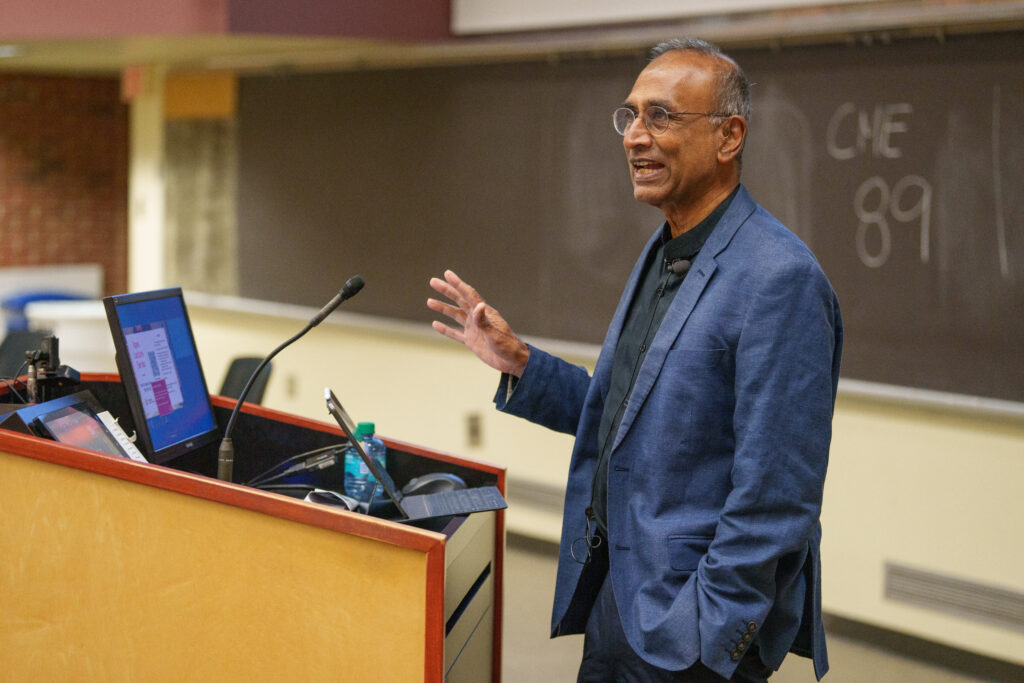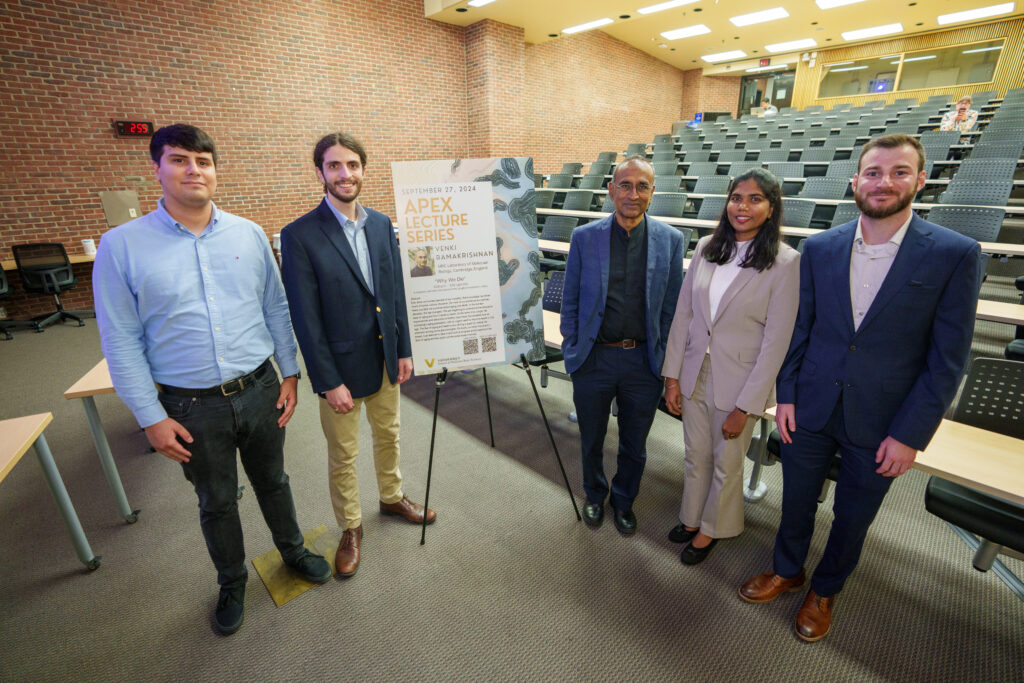On Sept. 27, Nobel Prize-winning molecular biologist Venki Ramakrishnan gave a captivating talk about the complex science of aging and human mortality. This presentation, part of the School of Medicine Basic Sciences Apex Lecture series, was based on his best-selling book of the same name “Why We Die.”

“Venki’s book takes us on a fascinating journey to explore the fundamental biological processes that lead to the inevitable end of our lives,” John Kuriyan, dean of the School of Medicine Basic Sciences, said as he introduced Ramakrishnan to a packed room. Kuriyan—a longtime friend of Ramakrishnan’s—described Ramakrishnan’s research background, including his stint as the president of the Royal Society and his receipt of the 2009 Nobel Prize in Chemistry for studies of the structure and function of the ribosome.
What happens when the ribosome—a cell’s “machinery” that makes proteins based on DNA’s instructions—breaks down and ages?
Ramakrishnan answered this question, among others, in his latest book and in the Apex presentation he gave. He discussed why aging happens, how it varies across species, and what science is doing to address the aging process.
“You can think of me as somebody whose work is close to the aging field but not in the aging field,” Ramakrishnan, leader of the MRC Laboratory of Molecular Biology, said. “You can think of me as a kind of anthropologist of the aging research community.”
He began his talk by citing examples of aging in different species, from mayflies—which live for only a day—to the Greenland shark species—which can survive for over 400 years. This variability, he explained, is largely the result of evolutionary pressures.
“Evolution doesn’t select for longevity,” he said. “It selects for fitness.”

Ramakrishnan delved into the evolutionary trade-offs that favor reproduction over longevity, explaining that natural selection prioritizes traits that aid survival and reproduction even if they contribute to aging later in life. Organisms that must reproduce quickly due to high predation or environmental risks tend to have shorter lifespans, while others, like some jellyfish, may avoid aging entirely, showing no signs of biological decline.
He also discussed the idea that aging is not inevitable. While humans currently live to an average of about 80 years, with a small number reaching 115 or even 120 years old, the potential for longer lifespans exists. He pointed to organisms like the hydra, a freshwater creature that shows no signs of biological aging, and speculated on whether humans might one day benefit from similar regenerative processes.
“We have a natural limit to our lifespan, but it may theoretically be possible to exceed it,” he said.
Ramakrishnan’s book also explores emerging therapies and interventions, such as caloric restriction and genetic reprogramming, which are showing promise in extending healthy lifespans. His book and talk highlighted work by start-ups and research institutes, such as Altos Labs, which are investing billions of dollars in longevity research.
Beyond the biology, Ramakrishnan touched on the societal implications of longer lifespans. As populations age, the demand for healthcare and social services will increase, requiring innovative solutions to maintain healthy and productive lives for older individuals. He underscored the importance of developing strategies to not only extend life but ensure that people live those extra years in good health.
In closing, Ramakrishnan emphasized that while there is no fixed limit on how long humans can live, the real challenge lies in addressing the biological and environmental factors that drive aging. Although science may not provide eternal life, it is well on its way to making significant strides in delaying the onset of age-related diseases and extending the period of life lived in good health.

Following the conclusion of Ramakrishnan’s presentation, he participated in a graduate panel discussion that included students across all Basic Sciences Departments. The panel featured graduate students Ronan Bracken (Biochemistry, Jonathan Brown lab), Eric Donahue (Cell and Developmental Biology, Kris Burkewitz lab), Haswitha Sabbineni (Molecular Physiology and Biophysics, Nancy Carrasco lab), and José Zepeda (Pharmacology, Brad Grueter lab). The four graduate student panel asked questions including whether aging is a disease, what the standards of caloric and dietary restrictions are, and how scientists can work for more reproducible and rigorous experiments.
Once panel participants and audience members wrapped up their questions, attendees enjoyed a reception in the Langford Auditorium atrium. Food, drinks, and conversation were aplenty as discussions surrounding the molecular mechanisms of aging continued.
For those with a VUNetID, the full, recorded lecture can be found here. https://mediasite.app.vumc.org/Mediasite/Play/42db8c7841d34c238b558cb57393e3f91d